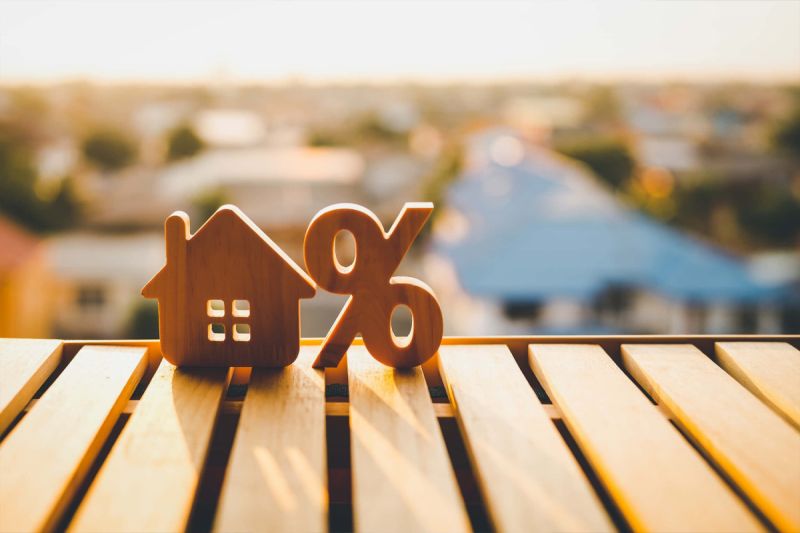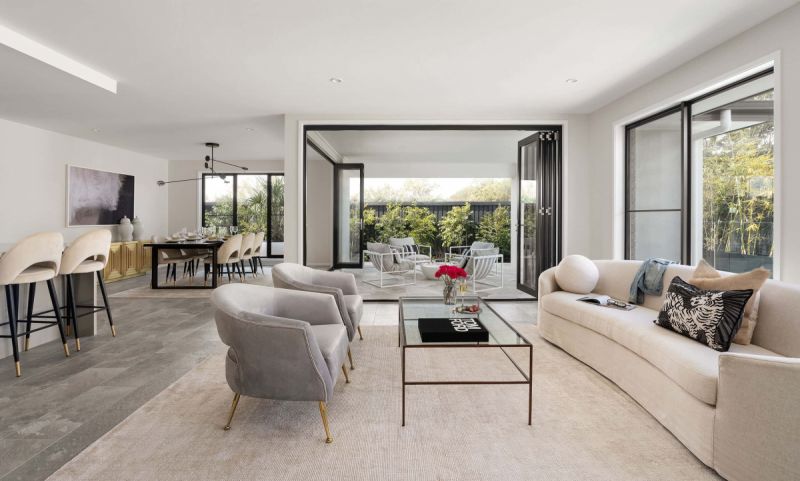The best options for flooring
Choosing the right type of flooring for your home relies on a few factors: budget, functionality, style, and durability, to name a few. There are endless choices available! To make this task less overwhelming, arm yourself with information about each type of flooring and assess it against your needs.
Here are some important things to consider when choosing flooring materials:
- Are you on a budget?
- Do you live by the beach or have a pool?
- Do you have kids and/or pets?
- Do you need low-maintenance flooring that's easy to clean?
- Do you require soundproofing?
Here are the most popular types of flooring types for homes.
Laminate flooring
Laminate flooring is made up of multiple layers of material. The top layer is a hard, transparent wear layer that provides protection against scratches, stains, and fading. This layer is usually made from aluminium oxide or melamine resin, which is a type of plastic. Beneath the wear layer is a printed layer that can mimic the look of various materials, such as wood stone, or tile. The printed layer is followed by a core layer, which is typically made from high-density fibreboard (HDF) and a backing layer that provides stability and moisture resistance.
Laminate flooring is a popular choice for homeowners because it is durable, easy to maintain, and less expensive than natural materials like hardwood or stone.
As one of the best budget flooring options, laminate flooring has made a real comeback. It emulates the clean and natural look of a timber surface but at an affordable price. Water resistance isn't a strong suit for laminates, so avoid placing it in high-moisture or wet areas such as the bathroom and laundry area.
Best flooring for: Low-moisture areas in the house (living room and bedroom)
The benefits of laminate flooring
- Cost-effective
- Natural-looking
- Plenty of designs on offer
- Stain-resistant
- Easy to clean and maintain
- Easy to remove
The disadvantages of laminate flooring
- Not suited for high-moisture areas
- Not soundproof
- Limited repair options
- Not environmentally-friendly
Vinyl
Vinyl is a type of synthetic flooring material that is made from polyvinyl chloride (PVC) and other additives. It can be produced in a variety of forms, including sheets, tiles and planks, and is available in many different colours and patterns to suit different design styles.
Vinyl flooring is durable, easy to maintain and relatively affordable, making it a popular choice for homeowners. It is also water-resistant and can be installed in areas like kitchens and bathrooms. Some vinyl flooring products are designed to mimic the look of natural materials like hardwood, stone, or ceramic tiles, achieving a natural look at a lower cost.
Vinyl's plastic composition makes it a superb choice for high-moisture and high-traffic areas. Install it anywhere within the home - even hallways! If you want to err on the side of caution, opt for waterproof vinyl flooring in the wet areas of your home.
Best flooring for: High-moisture and high-traffic areas
The benefits of vinyl flooring
- Cost-effective
- Water-resistant/Waterproof
- Longer lifespan than laminate
- Easy to clean and maintain
- Easy to install
The disadvantages of vinyl flooring
- Pricier than laminate flooring
- Difficult to remove
Tile flooring
Tiles have long been a flooring favourite. Known for their tough composition, tiles are difficult to scratch or dent. While tiles are often used in wet areas, you can also install them in other areas. Tiles are hard-wearing and aesthetically pleasing - creating a contemporary or even industrial look for the house.
There are three main types of tiles
- Ceramic tile - Made from clay and other natural materials
- Porcelain tile - Made from clay, but they are denser and less porous than ceramic tiles
- Natural stone tile - This includes materials like marble, granite, slate, and limestone, which are quarried from the earth and cut into tiles
Best flooring for: All rooms (especially wet areas)
The benefits of tile floors
- Cost-effective
- Water-resistant/Waterproof
- Longer lifespan than laminate
- Easy to clean and maintain
- Easy to install
The disadvantages of tile floors
- Pricier than laminate flooring
- Difficult to remove
- Cold underfoot and don't retain heat
Carpet
Carpets are a stylish, versatile and durable flooring option. They add comfort and warmth to the communal and resting spaces of your home.
Carpets have good sound and heat insulation and can be luxuriously soft underfoot depending on the carpet and underlay you choose. As carpets can be susceptible to stains and water damage, they may not be suitable for heavy foot traffic from children or pets.
Best flooring for: Bedroom, living room, playroom, hallways, stairs
The benefits of carpet
- Durable
- Stylish, luxurious, comfortable
- Heat and sound insulation
- Easy to maintain
The disadvantages of carpet
- Prone to stains and water damage
- Comparatively expensive
Hardwood timber/Solid timber flooring
Hardwood or solid timber floorboards are the ultimate home upgrade for many homebuyers. Their timeless appearance suits all home interior design styles and can even boost resale interest. Solid timber floors are available in various wood types such as oak, cherry, or walnut. They come with a hefty price tag per square foot and require professional installation.
To maintain sheen and remove scratches, timber flooring needs regular maintenance through sanding and refinishing. Protect your hardwood floor by throwing in some rugs for added comfort and protection.
Best flooring for: All rooms, excluding high-moisture areas
The benefits of solid timber flooring
- Highly durable
- Can add to resale value
- Stylish
- Easy to keep clean
The disadvantages of solid timber flooring
- Costly
- High-maintenance (requires regular sanding)
- Requires professional installation
Hybrid flooring
Hybrid flooring is a relatively new type of flooring material that combines the best features of laminate flooring and vinyl flooring. It is typically made of a multi-layered construction that includes a high-density core, a stabilising layer, a photographic layer that simulates the look of natural materials like timber or stone, and a clear protective layer. This means it's 100% waterproof, extremely durable and easy to clean!
Hybrid's appearance and appeal also mimic the beauty of hardwood floors without the hassle of maintaining them.
Best for: All rooms (especially wet and high-traffic areas)
The benefits of hybrid floors
- Highly durable
- Stylish and timeless, like hardwood flooring
- Suits extreme weather conditions
- Stain and scratch-resistant
- Easy to clean and maintain
- DIY friendly
The disadvantages of hybrid floors
- Costly
Engineered timber flooring
Engineered wood flooring is made from hardwood timber veneer glued to a multi-layered backing material made of high-density fibreboard (HDF) or plywood, which provides stability and durability.
Engineered timber floors offer the look and feel of solid hardwood floors at a lower cost. They can also be sanded and refinished multiple times, just like solid hardwood floors.
Best flooring for: Living areas and bedrooms
The benefits of engineered flooring
- Water-resistant
- Durable
- Stylish and natural-looking
- Easy to maintain
- Sustainable
- Less expensive than timber flooring
The disadvantages of engineered flooring
- Not waterproof
- Susceptible to scratches
- More expensive than laminate or vinyl flooring
- Limited refinishing options
Bamboo flooring
Bamboo flooring is made from the bamboo plant. It is a renewable and sustainable material that is becoming increasingly popular as an eco-friendly flooring option. Bamboo is actually a grass, not wood but it has similar properties to hardwood and is often used as a hardwood flooring alternative.
Bamboo flooring is available in two main types: solid and engineered. Solid bamboo flooring is made from solid pieces of bamboo that have been cut into planks, while engineered bamboo flooring is made from a thin layer of bamboo that is glued onto a backing material. Bamboo flooring is available in a range of colours and finishes and can be stained to achieve a variety of looks.
Best for: Bedrooms, living areas and dining areas
The benefits of bamboo flooring
- Eco-friendly
- Durable
- Unique appearance
- Low cost
The disadvantages of bamboo flooring
- Vulnerable to moisture
- Susceptible to scratches and denting
Polished concrete
Polished concrete flooring involves laying then grinding down a concrete surface to a smooth, glossy finish. This finish is achieved through a process of mechanically grinding and polishing the surface with progressively finer tools until the desired level of shine is achieved.
Best flooring for: Living areas, kitchens and hallways
The benefits of polished concrete floors
- Sustainable/Renewable material
- Highly resistant to wear and tear
- Suitable for heavy foot traffic areas
- Easy to clean
- Highly customisable
- Stylish and unique
The disadvantages of polished concrete floors
- Expensive
- Difficult to install
- Cold underfoot
- Vulnerable to cracking
Reclaimed timber flooring
Reclaimed timber flooring is an environmentally friendly option using recycled wood from old buildings or structures such as barns, factories, or warehouses. The wood is salvaged and repurposed to create new flooring, reducing the need for new timber to be harvested.
Best flooring for: Eco-conscious, all rooms, excluding high-moisture areas
The benefits of reclaimed timber floors
- Eco-friendly and sustainable
- Adds character
- Durable
The disadvantages of reclaimed timber floors
- Can be expensive due to salvaging costs
- Requires more maintenance
- Susceptible to wear and tear
Stone flooring
There are many different types of stone that can be used for flooring, including granite, marble, limestone, travertine, slate and sandstone. Stone flooring is a popular choice for both indoor and outdoor spaces and can be used in a variety of interior design styles, from rustic to modern.
Best for: Outdoor areas, bathrooms and kitchens
The benefits of stone floors
- Durable and long-lasting
- Natural beauty
- Unique patterns and colouring
- Popular with home buyers
The disadvantage of stone floors
- Expensive
- Prone to chipping
- Cold underfoot
Linoleum flooring
Linoleum flooring is a type of resilient flooring made from natural materials such as linseed oil, wood flour, and cork dust, as well as resins and pigments. It was first developed in the mid-19th century as a durable and eco-friendly alternative to other flooring materials of the time. Today, many products that replicate the look of traditional linoleum are made from synthetics so be sure to check with the manufacturer.
Best flooring for: Kitchens, entryways and hallways
The benefits of linoleum flooring
- Low cost
- Highly durable
- Scratch resistant
- Wide range of designs and colours
- Eco friendly (check with the manufacturer)
The disadvantages of linoleum flooring
- Vulnerable to fading
- Susceptible to water damage
- Can look cheap
- Modern linoleum can be made from synthetic materials
Cork flooring
Cork flooring is made from the bark of the cork oak tree. The bark is harvested every 9-12 years without harming the tree and then processed into tiles or planks for flooring. Cork flooring has a distinctive look and texture with a warm, natural appearance.
Best for: Hallways, bedrooms, kitchens and bathrooms
The benefits of cork flooring
- Naturally resistant to water, mould, and mildew
- Soundproof
- Good insulator
- Eco-friendly and biodegradable
- Great for asthma or allergy sufferers
The disadvantages of cork flooring
- Susceptible to water damage
- Susceptible to fading and discolouration
- Expensive
- Vulnerable to scratches and dents
What are floating floors?
Floating floors refer to a method of installation where the flooring material is not directly attached to the subfloor. Instead, the flooring material "floats" on top of an underlayment layer, which helps to absorb sound and provides cushioning.
Floating floors can be made from a variety of materials, including hardwood, engineered wood, vinyl, and laminate.
Floating floors and laminate floors are different, although these terms are often used interchangeably.
While some laminate flooring can be installed using the floating method, not all floating floors are made from laminate. For example, hardwood and engineered timber flooring can also be installed as floating floors. It's important to understand the differences between floating floors and laminate floors when considering different flooring options for your home.
Want to find the perfect flooring options for your home?
If you're reading this before your colour appointment, you've covered the basics of flooring. Armed with this flooring knowledge, all you need to do is turn up and choose the right type for your home!
For more information on colour appointments and how we can guide you through your building journey, check out our Step-by-Step Home Building Guide.





